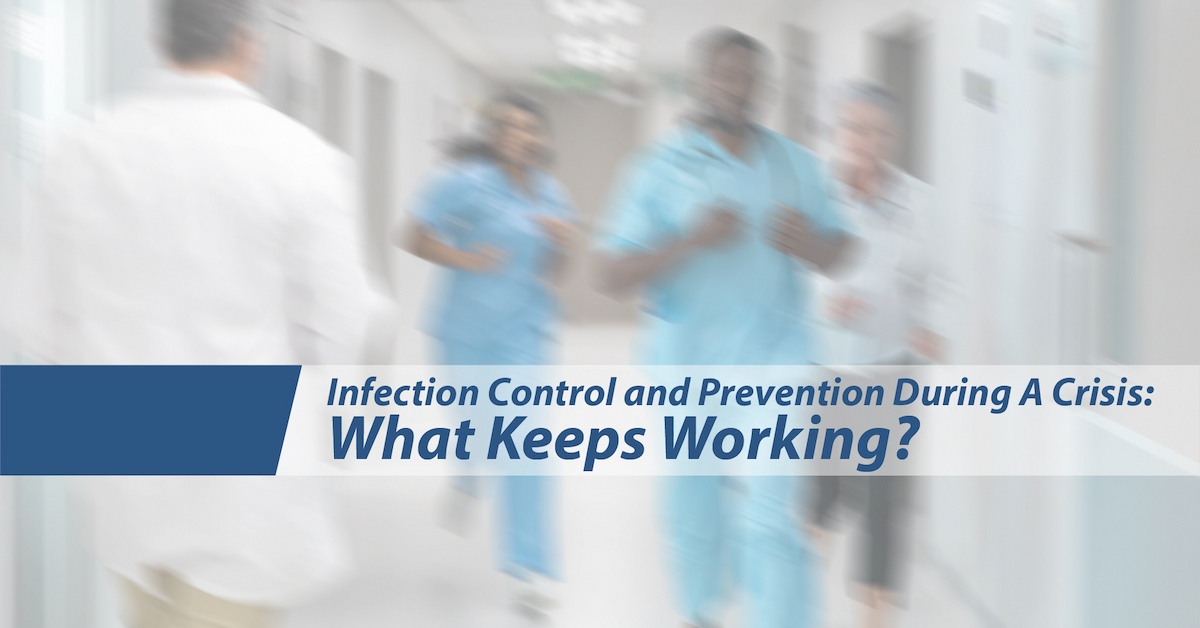Infection Control and Prevention During A Crisis: What Keeps Working?

 Before COVID-19, the field of infection control and prevention was making incredible progress. Putting in place protocols and ensuring consistent surveillance and feedback was enabling the staff in hospitals and facilities to reduce infection and transmission rates of hospital-acquired infections (HAIs) such as central line infections and ventilator-associated pneumonia. But once the pandemic hit and the staff were bombarded by an influx of seriously ill patients, often at numbers that strained or exceeded the facilities, many of those protocols and processes had to be put aside to deal with the emergency at hand. As a result, some HAIs saw dramatic increases. We saw first-hand what happened when staff and resources were suddenly curtailed. What if there were infection control and prevention tools that could persist even during times of crisis?
Before COVID-19, the field of infection control and prevention was making incredible progress. Putting in place protocols and ensuring consistent surveillance and feedback was enabling the staff in hospitals and facilities to reduce infection and transmission rates of hospital-acquired infections (HAIs) such as central line infections and ventilator-associated pneumonia. But once the pandemic hit and the staff were bombarded by an influx of seriously ill patients, often at numbers that strained or exceeded the facilities, many of those protocols and processes had to be put aside to deal with the emergency at hand. As a result, some HAIs saw dramatic increases. We saw first-hand what happened when staff and resources were suddenly curtailed. What if there were infection control and prevention tools that could persist even during times of crisis?
Several studies have demonstrated how infection control and prevention were impacted by the COVID-19 pandemic, but they can be boiled down to one phrase: Too many patients, not enough staff. There were so many consequences of this pandemic pressure, resulting in a chain reaction from outside pressures all the way to patient outcomes.
The sudden influx of seriously sick patients paired with the almost immediate impact on staffing demands led to our healthcare systems becoming overwhelmed. When hospitals and facilities became short-staffed, both due to higher numbers of intensive care patients as well as by the healthcare workers becoming ill themselves, this set off a chain reaction, all due to suddenly having less time to treat patients. For infection control and prevention, this meant less time for preventative measures such as surveillance, real-time reporting, and unit feedback about infections. Protocols were also affected: There was less time for chlorhexidine bathing, universal decolonization, and blood sampling (to culture for early signs of infection).
Even processes with direct patient contact were impacted: There was less time for central line and ventilator checks, and even less time for direct patient interaction (especially once hospitals started putting device readout screens in the hallways to avoid contact with infected patients). Even travelling, temporary healthcare workers brought in to areas of greatest need did not solve the issues with infection control and prevention; many of these workers may not have been familiar with the processes of their temporary position, whether they came from across the country of just up from a different department to help out on a COVID ward. Due to the influx of patients and the severely reduced staff, many preventative infection control and prevention measures did not persist.
Added to the decreased time was also the increased severity of the patients being treated. COVID patients require more indwelling devices, including central lines and ventilators, which increase the risk of HAIs right away. Additionally, their need to be prone for treatment could lead to dangerous gaps in IVs and devices where pathogens could enter. COVID patients often developed secondary bacterial infections which required increased antibiotic use, which also puts a patient at risk for certain HAIs. All of these issues, on top of a severe shortage of personal protective equipment (PPE), meant poorer outcomes for patients and their caregivers.
So what did this pandemic teach us? When everything depends on human processes, there will be inevitable breakdowns in infection control and prevention, especially during times of crisis. Looking to the future, we can learn an important lesson: We need infection control and prevention tools that persist even during times of increased patient needs and decreased staff time. Even on a good day, hospitals and facilities feel the pressures of maintaining the human processes that keep infections at bay, from hand hygiene compliance to reprocessing equipment properly. Preventive biocidal surfaces, for example, can help staff keep patient areas free from pathogens, without asking them to do any extra work or remember to do anything at all. During times of crisis, when staff time is even more limited, these types of preventative interventions are even more valuable.
![EOScu Logo - Dark - Outlined [07182023]-01](https://blog.eoscu.com/hubfs/Eoscu_June2024/Images/EOScu%20Logo%20-%20Dark%20-%20Outlined%20%5B07182023%5D-01.svg)




